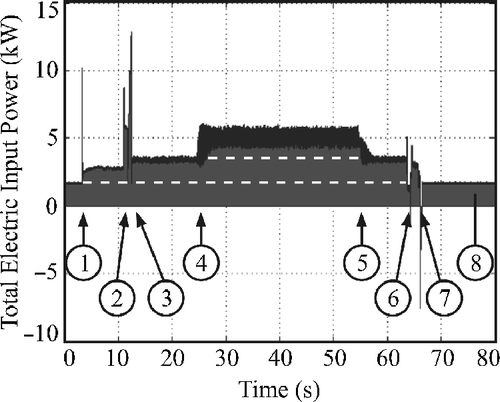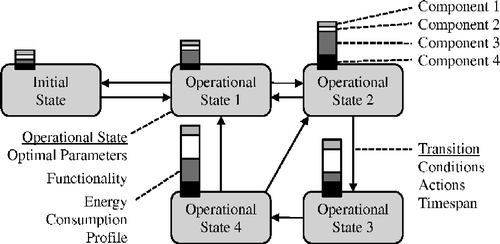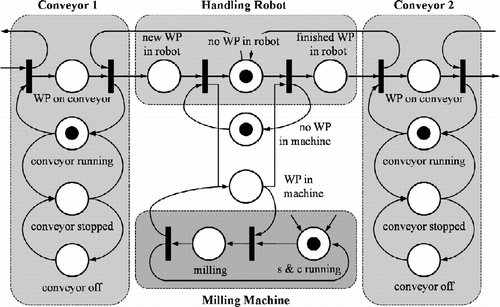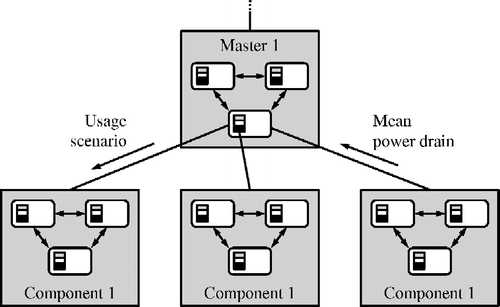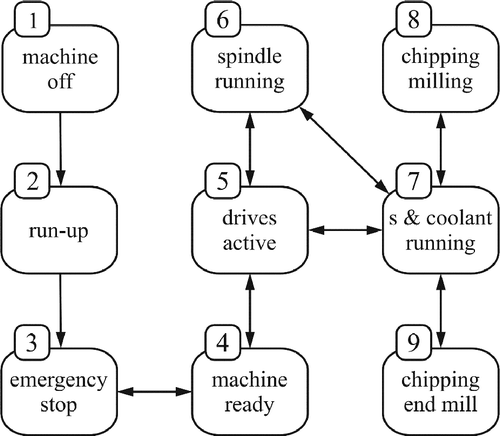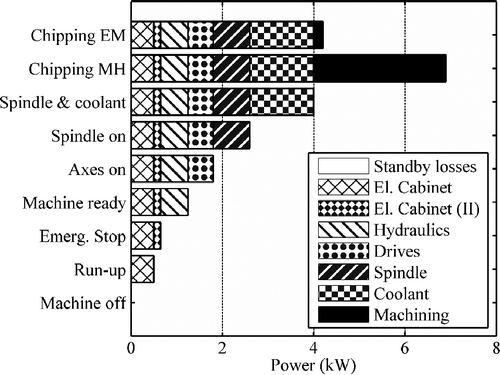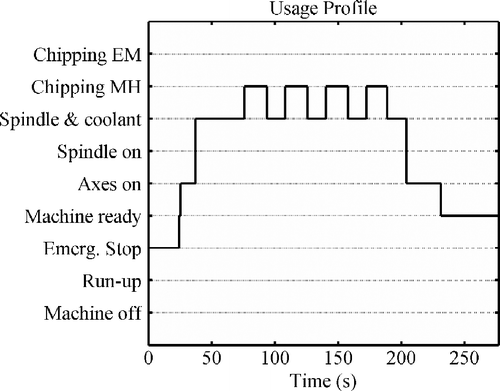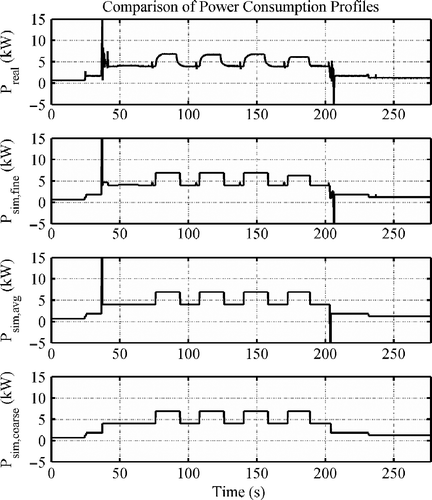Abstract
Today, energy efficiency in production systems has partially been achieved on the component level, but methods are missing for the energy optimal operation of plants, machines and components. We therefore, propose a novel generic method to model the energy consumption behaviour of machines and plants based on a statistical discrete event formulation. It is lean, integrative and scalable and can be used directly in planning processes to make predictions of the energy consumption of different configurations in different scenarios based on any amount of available information. Using the modelling framework, we introduce applications in real-time, tactical and strategic decision making processes that make it possible to exploit the potential for energy consumption minimisation of any given machine or production system while obeying conflicting general conditions.
1. Introduction
Over the last years, new economies have entered the competition for resources with force, while sustainable sources of energy have not been made available to the same extent. In countries with a traditional focus on industrial production, the energy intensity persists, with industrial production being responsible for 27% of the primary energy consumption and 47% of the electrical energy turnover in Germany (Arbeitgemeinschaft Energiebilanzen Citation2006, Umweltbundesamt Citation2007). As a result, the energy prices have experienced a sharp increase and brought the cost for energy onto the agenda of manufacturing enterprises. Moreover, as most means to produce energy result in the emission of carbon dioxide to the atmosphere, human induced climate change is directly linked to the energy consumption worldwide and is expected to lead to additional cost in the future.
Motivated by the global responsibility for ecologic sustainability as well as the economic pressure introduced by the increasing competition for energy resources, it has become a high-priority target to optimise the energy efficiency of manufacturing systems. However, it is not trivial to achieve minimum energy consumption at the same time as other vital objectives like minimum total cost, processing time, superior surface quality, low system complexity and robustness against disturbances and uncertainties. Today, human-driven as well as automated decision processes that are employed to find a solution to the required trade-off rely heavily on subjective heuristic strategies which often neglect the actual problem complexity and include misleading intuitive information. One typical example is the common assumption that slowing down the production processes during times of low utilisation would always lead to higher energy efficiency.
As a basis for a more objective reasoning, we propose a novel generic method to model the energy consumption behaviour of machines and plants based on a statistical discrete event formulation. It is lean, integrative and scalable and can be used directly in planning processes to make predictions of the energy consumption of different configurations in different scenarios based on any amount of available information. Using this modelling framework, we introduce decision-making processes on the real-time, tactical and strategic level. This includes real-time setting of machine parameters which are optimal under the criteria and priorities of the current situation, energy optimal resource allocation in tactical manufacturing planning, energy efficiency controlling and strategic decision support. The methods on the tactical and strategic level can be realised in a human-centric approach supported by software built around the proposed energy consumption model, while the real-time methods can be implemented directly into automatic control systems. In that way, it is possible to fully exploit the potential for energy consumption minimisation of any given machine or production system while obeying any given set of general conditions. Moreover, the proposed modelling approach allows assessing the energy consumption of a planned machine or production system for the foreseen application in early design stages and, consequentially, makes it possible to select the most energy efficient option.
This paper is subdivided into three main sections. In Section 2, we will give a short overview of the established approaches to energy efficient production. A novel approach to energy consumption modelling will be introduced in Section 3. In Section 4, we illustrate the potential of the modelling approach by presenting four application areas. We will conclude our paper with an outlook on future work in the presented line of research.
2. Present approaches to energy efficient production
Traditionally, efficiency research for the manufacturing industry has put an emphasis on increasing the reliability of machines and on reducing tooling times by increasing the motion dynamics, often at the expense of higher energy consumption (Berkemer Citation2006). Due to the increasing demands on the performance of production machines, the energy efficiency of the German industry, defined as added value per consumed energy, has actually declined (Umweltbundesamt Citation2007). Life cycle costing approaches have shown, though, that energy expenses can have an equal financial impact as machine faults (Abele Citation2006). The basic consumption of an inactive machine tool, i.e. wasted energy in inactive periods, typically lies in the area of 30% of the energy intake at full work load (Neugebauer et al. Citation2008). In addition to raising the problem awareness of people worldwide, this has led to legislative pressure. A recent directive of the European Parliament aims to establish a framework for the setting of ecodesign requirements for energy-using products (European Parliament Citation2005). The final report of a study group initiated by the European Commission cites tool machines as a top three priority for inclusion into the product categories to be regulated in this framework (EPTA Citation2007).
2.1 Energy efficiency measures
For the reasons mentioned above, in addition to personal and governmental initiatives motivated by the need to counteract the climate change, energy efficiency has been raised to the agenda of the manufacturing industry due to economic considerations. Consequentially, a selection of energy efficient basic components for machine builders is available today and simple rating systems like the EFF classes are applied (Eurodeem Citation2007). The Efficiency Valuation Organisation and local organisations provide information and services to identify energy savings that can be realised, e.g. by improving thermal insulation and replacing old components with new, energy efficient ones.
While the work in the Collaborative Research Center SFB 144 revolved around energy and resource efficiency in production in general, first detailed steps towards a characterisation of the energy consumption of production machines have been taken in the course of the Swiss RAVEL impulse program (Zirn Citation1995) and other authors have followed suit, e.g. Eckebrecht (Citation2000).
In a relatively small number of projects, specialised techniques have been developed to raise the energy efficiency of machines. While the Framework Programme 5 project ENGY provided ideas on how the energy consumption of grinding machines can be minimised, the ongoing research in the Framework Programme 6 project EcoFIT aims at improving the energy efficiency of production machines in general by minimising the amount of accelerated and decelerated mass (Sekler et al. Citation2007). It is expected that even idle running energy losses can be reduced as lower power motors are sufficient for the resulting light weight machines.
The energy efficiency of manufacturing processes has also been studied. Active process energy losses are typically at around 60% during rough milling and at around 95% for finishing (Herfurth Citation1989). The idea that higher chipping thickness often leads to better energy efficiency result is confirmed by Kober et al. (Citation1997). A good selection of the manufacturing process can lead to a systematically lower energy input (Sweeny et al. Citation1996).
While there are a number of papers on energy efficiency optimisation for a single machine or workpiece, the energy efficient operation of manufacturing plants has not yet been extensively examined and only a few results can be found in the literature. In a recent publication, Mouzon and Yildirim (Citation2008) demonstrate that it is possible to include energy efficiency as a goal in multi-criterion scheduling optimisation. They produce promising first results, but the extent of optimisation achievable is limited by the coarse energy consumption model they use. On the machine control level, energy optimal trajectory planning has long been a research topic in robotics (e.g. Gordeau and Schwartz Citation1989), but the savings which can be achieved through trajectory planning are limited for many production machines. Today, methods for the overall energy consumption minimisation in machine and plant planning and control are still missing.
2.2 Production machine energy consumption modelling
Even though the described projects and initiatives all contribute to a better understanding of the energy consumption and potentially to its reduction, the results are not given in a form that supports optimisation decisions for a broad range of general production systems, and the general knowledge decisions are based on is still weak. Besides access to capital and technical risk, an information deficit is regarded as a major barrier for the justification and implementation of energy efficiency measures in companies (Rohdin et al. Citation2007).
Unfortunately, the theoretical minimum energy required for a manufacturing operation is often unknown, and thus instead of the computation of a general degree of efficiency, a comparison of different solutions for a fixed scenario is made based on the absolute amount of energy consumed. For the computation of the overall efficiency of a production, it would be convenient to calculate the monetary value of the energy consumption and all other efforts and relate them to the monetary benefit. But as Bertoldi and Kromer (Citation2005) point out, it is difficult to predict the monetary value of efficiency due to the high volatility of the energy markets. Therefore, in the case of cutting processes like milling or turning, where material removal is the primary objective, the specific consumed energy e proc and the specific processing power p proc(t) are often computed as objective key figures from the processing power P proc(t), its energy integral E proc, the material removal rate and the volume of removed material V rem:
This allows comparing the efficiency of different process alternatives, and can be extended to different production alternatives (Kober et al. Citation1997). Consequentially, the specific consumed energy as an efficiency indicator is applied in Schiefer (Citation2001) and Abele et al. (Citation2006), but this characteristic figure does not give detailed information on what measures could be taken to improve the operational energy efficiency of a production plant. Moreover, the specific energy consumption as a single key figure does not include any information about other objectives, like for example surface quality. Nevertheless, specific energy key figures can be used for comparison and controlling.
A different case is represented by the machine efficiency. There, the instantaneous power required by the manufacturing process can be related to the actual instantaneous power consumption of the machine:
The machine power consumption can be measured directly at its mains power connection, and, in the case of chipping, the process power can be computed by multiplying force and speed or torque and turning rate. Integrating the power over the time a processing step requires leads to the energy turnover and, consequentially, the degree of efficiency of a machine for a process step can be quantified:
Figure 1 An example Sankey diagram illustrating the distribution of the power consumed into losses and effective power for a typical machine tool (adapted from Gloor Citation2000).
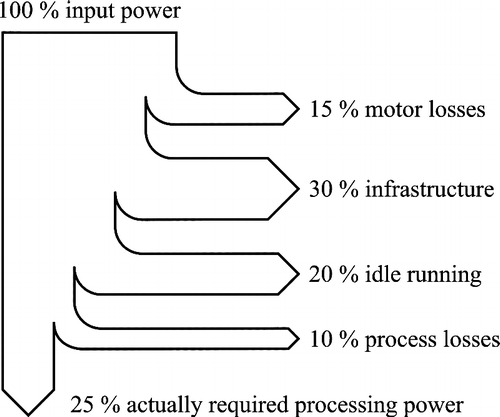
It is important to keep in mind that the metrics and their definitions and interpretations are critical for the assessment of energy efficiency. For example, if an optimised manufacturing process leads to a reduced consumption of coolant, the percentage of manufacturing process energy flow in the Sankey diagram is increased, which might give the misleading idea that the process efficiency was reduced. Moreover, the basis of the calculation has to be chosen carefully during selection of the system boundaries. For example, the operation of a machine typically requires services like waste reprocessing which have to be included into the calculation, and waste heat from the cooling network can be turned into effective energy for heating so that it has to be removed from the waste energy share.
2.3 Modelling usage-dependent energy consumption
Degrees of efficiency as well as Sankey diagrams, on the one hand, are useful to describe the instantaneous distribution of input power into effective power and power losses and, therefore, the efficiency at each point of time, like in Equation (Equation2). On the other hand, they can be applied to illustrate the average efficiency of a device by relating the cumulated effective and waste energy over a period of time to the cumulated input energy, like in Equation (Equation3
). They can be applied to production machines and their components which show a variable energy intake and effective power based on their operational profile. Care must be taken as nominal power values do not provide the information required for efficiency related decisions and may even be misleading. Moreover, neither degrees of efficiency nor Sankey diagrams provide a formalism to describe the relation between different operational profiles and the resulting energy efficiency.
Draganescu et al. (Citation2003) have introduced a detailed model of the specific energy consumption for milling manufacturing processes. They established the dependencies between the process efficiency and major cutting parameters and showed that the energy consumption of a machine is dependent on process force in a non-linear fashion. In their publication, they show characteristic maps for the degree of efficiency of a milling machine as a function of technological parameters. While these diagrams, in contrast to Sankey diagrams, describe the relation between operation and efficiency, they are unwieldy for large numbers of parameters. Moreover, diagrams are specific for a single machine and manufacturing process and the authors do not give information about what elements of their model can be transferred.
Dahmus and Gutowski (Citation2004) present results on energy consumption measurements for machine tools, and identify basic power, idle running power and cutting power consumption. They introduce a diagram formalism for load-dependent power consumption and give examples for different production machines. Unfortunately, the underlying model consists of only a linear interpolation between idle running power and full load power, and no mathematical rule is given for the mapping of the machine application to the degree of utilisation. Therefore, the formalism has to be seen as a tool for visualisation of fixed and variable power and not as a model for numerical optimisation.
Aiming at reducing energy cost in the foundry industry, the Swedish Foundry Association has started projects that build on discrete event simulation. In Solding and Petku (Citation2005) and Solding and Thollander (Citation2006), the authors argue that direct process-related energy consumption, overhead energy consumption and transformation losses can be included in existing production simulation systems. They present a simple modelling method which extends the stochastic event timing calculations of discrete event simulation with a simple calculation of the consumed energy based on a constant consumption rate and a lump-sum energy per event. Even though the model itself is appropriate for peak power and total energy optimisation of foundry processes, but not the complex operations of machine tools, the general approach can be extended by the modelling technique described in this paper.
The scheduling optimisation presented in Mouzon and Yildirim (Citation2008) is based on a similar simple energy consumption model which consists of only three parameters, idle power consumption, processing power consumption and energy consumed during start-up of a machine. While the basic approach of assigning different operational states different levels of energy consumption is promising, the low level of detail limits the model to crude optimisation.
3. A generic energy consumption model
Motivated by the limitations of existing approaches and focussing on the usage-dependent variability of the power intake, we propose a new modelling approach for the energy consumption of production systems, machines and components.
To illustrate the underlying idea of the modelling approach, we start with an example. Figure shows a typical power consumption profile of a machine tool with serial Cartesian kinematics performing a single milling operation. There, the actual input power at the main connection of the machine is plotted over time. Positive values denote consumed power, while negative values occur when, during deceleration phases, the machine's energy recovery system converts mechanical energy into electrical power which is fed back into the power grid. As highlighted in the diagram, the total energy intake for the execution of the milling operation is equal to the integral of the power over the entire operation of the machine. Darker areas of the graph indicate a fast oscillation of the power drain.
Seven events occur during the execution of the milling step: first, the coolant pump is switched on, then, the machine axes perform a rapid positioning motion and the tool spindle is speeding up. Between markers 4 and 5, the cutting of the workpiece takes place. When the machining operation is finished, the tool spindle and the coolant are switched off. Using the horizontal lines in the diagram, it is easily visible that the actual chipping is responsible for only a small portion of the energy consumed.
Obviously, the major part of the energy consumption is due to the permanent idle load of the machine, indicated with marker 8. Acceleration phases show very high amplitudes of power consumption, but their contributions to the energy balance are small due to their short duration and they are compensated to a large degree by the power fed back during deceleration. The higher the percentage of rapid positioning motions during the operation of a machine is, the more relevant the acceleration phases and thus the amount of accelerated mass become for the energy balance. This would, for example, be the case for handling and packaging machines.
From the given example, we see that the machine shows a number of different operational states which are linked to the operational states of its components and determine the power consumption. Executing the part program loaded into the machine control, the machine switches from one state to another at discrete points in time. While some of the states, e.g. the idle machine with active coolant pump, show a constant power drain, the power intake in other states depends on characteristic parameters. For example, the power drain during milling is dependent on the cutting process parameters. Similar observations can be made for other types of machines.
3.1 Basic model structure
From the observations we made from the example power measurement, we derive the basic structure of our generic energy consumption model in the form of a digraph with discrete states and transitions. Figure shows an example for an energy consumption model of a machine which can enter four active operational states. Each operational state is typically defined by the functionality the machine provides when it is in this state, e.g. rapid motion. For this functionality, a set of optimal machine parameters can be found that leads to energy optimal behaviour of the machine and is associated with the operational state. The third aspect of each operational state is the energy consumption profile which consists of the combined power drain levels of all active components of the machine. In a mathematical formulation, a state S i can be given as a tuple:
The operational states are linked by transitions which define the other operational states to which a machine can switch from its present state, illustrated by arrows in Figure . In some cases, certain conditions may have to be valid for a transition to become active and actions may be linked to the transitions, e.g. switching on the coolant. Some transitions may require a time span to elapse before the target operational state is reached, e.g. the speeding up of a spindle, or may require the machine to have been in its present state for a given amount of time, e.g. during warm up before a precise tooling operation can take place. In a mathematical formulation, a transition T i is defined as:
Using this basic discrete event model, any operational profile of a machine can now be given as a trajectory in the space of operational states. An example for such a trajectory, which is typically defined by the program executed on the machine control and external inputs from a master control and the machine operator, is shown in Figure .
For the execution of any manufacturing operation of a machine described by the state machine from Equations (Equation4) and (Equation5
) given in the form of such a trajectory defined by a sequence of transitions (t
k
,T
i(k)) so that:
3.2 Stochastic extension of the model
If no discrete set of state trajectories is given for an energy consumption analysis scenario, a stochastic extension of the model presented in the previous section can be used to evaluate the mean power consumption, its variance and extremal values. We propose to employ a semi-Markov process, also called Markov renewal process, to define a machine usage scenario using probabilities. The model is given by a pair of stochastic processes (X,Y) where:
The formulation of transitional probabilities and stochastic switching times replaces the transitions given in Equation (Equation5) so that the model is now specified by the tuple (S,X,Y). The deterministic time constraints given in Equation (Equation5
), t
Trans being the time elapsed between initiation of the transition and switching to S
m
and t
S
n
, min being the minimum time the machine has to remain in state S
n
before the transition becomes active, can be incorporated into the formulation of the stochastic process Y. The pairs of original state S
n
and target operational state S
m
as well are replaced by the probability p
mn
(k), while the logic condition C for a transition to be active is covered by its dependence of k.
Using the stochastic extension of the generic energy consumption model makes it possible to conduct stochastic simulations and to estimate the energy consumption of a machine by employing tools of mathematical analysis. This modelling technique is new to the area of production optimisation, but some inspiration can be obtained from literature on the energy consumption modelling for battery powered mobile devices (Kravets and Krishnan Citation1998) and sensor networks (Wie et al. Citation2006). Some researchers in this area have employed Markov chain models to describe the user behaviour to optimise power management and maximise battery life (Qiu and Pedram Citation1999). The models under consideration there are of much lower complexity than production systems so that further research is required.
3.3 Combinatorial explosion, hierarchical modelling and abstraction
An inherent problem with discrete event machine models is the combinatorial explosion of the number of system states if multiple component models with multiple states each are combined. This problem has to be overcome for the approach presented here, as typically production plants consist of multiple machines for manufacturing and handling tasks and each machine in turn comprises multiple active components. Obviously, the automaton resulting from the synchronous product of all component models would have an intractable amount of states.
One possible way to avoid combinatorial explosion is to maintain an aggregate model instead of computing and analysing the synchronous product. An aggregate model consists of a set of component models with synchronous transitions that link the individual automata. Each state that contains a marker contributes to the total energy consumption, thus allowing for bottom-up modelling of a system based on component models. It provides efficient, interpretable energy consumption modelling with zero loss of information, but does not reduce the computational complexity and data storage requirements. The principle of aggregate modelling is illustrated in Figure .
The second approach to complexity reduction is based on abstraction. Here, the energy consumption behaviour of a component is analysed for a stochastically defined usage profile using stochastic techniques on the formalism described in Section 3.2. The resulting mean energy consumption is then used as a component power drain parameter P c,i on the next higher level of abstraction. This method is suitable for efficient computation in cases where the long term behaviour of aggregated systems is studied for a large number of constant usage profiles, e.g. during the selection of strategic measures. An abstract model can be extended through top-down modelling, where detail on the component layer is added successively. Abstraction in multi layer models is illustrated in Figure .
4. Application of the energy consumption model
In this section, we will describe how the generic energy consumption model we introduced in Section 3 can be instantiated for a production machine and subsequently applied to decision making on the real-time, tactical and strategic level. The given examples are not exhaustive and other applications of the formalism will most probably be identified by the reader.
4.1 Example instance of a consumption model
As an example for putting the generic energy consumption model into practice, we present the basic model structure for a Hermle UWF1202 machine tool. The state/transition graph graphically representing Equation (Equation5) is given in Figure , and the power consumption of the machine components per state corresponding to Equation (Equation4
) is shown in Figure . The parameter information required for this crude model can be obtained with a small number of simple measurements or, with a degree of uncertainty, from the machine and component documentation.
This model can now be used to predict the energy consumption for any usage of the machine. An example usage profile corresponding to for a roughing operation is given in Figure by the sequence of points of time when the machine changes its operational state. In that way, one specific manufacturing operation is represented, while the overall usage of a production machine could be aggregated using the stochastic extension of the model introduced in Section 3.2.
The usage profile in Figure corresponds to a plane milling operation. During the execution of this milling operation, the power consumption P real at the machine main connection has been recorded and compared to the power consumption profile predicted using the basic model as well as two more refined variants (Figure ). Obviously, the most detailed version of the model tracks the power consumption accurately (P sim,fine), while the model introduced in this section seems to give only a crude representation (P sim,coarse). But even the coarse version of the model approximates the real energy integral to within 5%. The same applies to the simulation of the entire manufacturing of a workpiece.
4.2 Real-time application of the consumption model in machine controls
If implemented on a machine control, the state/transition model introduced in Section 3.1 can be used to provide flexible energy consumption optimisation. As has been stated in Equation (Equation4), each state is associated a set of parameters or rules for parameterisation which are considered to be optimal in terms of energy efficiency. Instead of having to solve the optimisation problem for the entire machine application, the problem is separated into simpler sub-problems associated with the operational states. Once an optimal parameter setting has been found for each operational state, the state machine formalism can be used to choose the optimal parameterisation in real time leading to an intuitive overall energy optimal operation of the machine. Most of the time, energy efficiency will not be the only requirement, but different situations occur during the operation of a machine that come with sets of conflicting demands of varying importance. This can be accommodated by introducing multiple alternative states into the model, each with a parameterisation which is optimal for one situation, or by run-time multi-criteria optimisation based on functional dependencies stored in the model. When a task is assigned to the machine, graph search techniques can be applied to find the state trajectory which is optimal under the set of criteria and weights associated with the job and the situation.
4.3 Energy-optimal resource allocation in tactical manufacturing planning
Typical problems in tactical planning in flexible manufacturing plants include the allocation of production resources for a number of concurrent jobs. Usually, different alternatives are possible and solutions are chosen based on minimum production time or capacity utilisation. The energy consumption model introduced in this paper adds the option of minimising the overall energy consumption of the production plant while maintaining all other goals. For each possible sequence of assignments of sub-jobs to machines, the resulting energy consumption can be estimated using the models of each machine and the usage profile associated with the sequence of operation, as has been shown in Section 4.1. The solution with minimum total energy consumption that obeys all other objectives can then be chosen. If, during operation of a manufacturing plant, demands change, e.g. because of an additional unforeseen job, a fast re-planning can be done which is energy optimal under the new circumstances. The generic energy consumption model can be combined with the energy aware scheduling optimisation technique developed by Mouzon and Yildirim (Citation2008) to raise the energy saving potential of that approach.
4.4 Energy efficiency controlling and strategic decision support
On the strategic level, the energy consumption model can be employed for energy efficiency controlling as well as decision support. During planning of a manufacturing plant, simplified energy consumption models can be used to analyse the energy impact of alternative solutions. In addition to that, provisions can be found and applied early in the planning process that ensure the energy efficient operation of the plant. If an energy consumption model is running on the machine control, it can be used to gather and aggregate energy consumption measurement data. In that way, an intelligent system is created which learns or updates the energy consumption profiles and, via hidden Markov channel estimation, possibly even the state model itself during operation of the machine. Using the techniques for aggregation introduced in Section 3.3, the energy consumption information can be condensed to provide key controlling figures. If these indicators are compared with the energy consumption predicted during planning steps, deviations point to planning errors, which can then be avoided in future decisions, or to unexpected problems. In the latter case, the model hierarchy can be followed down to more detailed levels until the cause of the unexpected energy waste is identified. We think that the energy consumption model presented here can be used as a component in many more general simulation systems to provide a basis for strategic decisions. For example, the SIMTER project aims to integrate environmental impact assessment including energy consumption calculation with discrete event simulation of production systems, ergonomics and automation level assessment (Lind et al. Citation2008).
4.5 Energy consumption profile assessment in early design stages
One of the most important advantages of the proposed modelling framework is that it can accommodate incomplete or heuristic knowledge. This allows making informed decisions in early design stages which determine the energy efficiency throughout the lifecycle of a machine. One example would be the decision whether to incorporate a costly control solution that allows a component to be set into a low-energy hibernation state. This can be analysed by simulating the usage profiles for the original model and a model with an added state. If the energy savings based on the optimal state trajectories exceed the required investment, the more expensive solution can be chosen as the more economic one. Moreover, if a machine designer has the choice between components of different energy efficiency classes, the usage profiles can be analysed to whether the operational states in which there are fundamental differences in the energy consumption of the alternative components occur often or rarely. In the latter case, the cheaper component can be chosen, as only small energy savings could be realised with the other. An important method for energy efficiency design optimisation will be sensitivity analysis, as outlined in Thollander et al. (Citation2009).
5. Summary and outlook
In this paper, we have presented a generic formalism that can be applied to describe how the energy consumption and thus the energy efficiency of machines and production systems relates to the way they are operated. The model therefore fills an important gap in existing methods for energy consumption modelling and simulation which has been shown in Section 2. In the context of the survey of presently accepted approaches to energy efficiency presented there, it becomes clear that the generic energy consumption model does not simply add to the multitude of specialised improvements, but is suitable to provide the basis for the energy optimal use of manufacturing plants, machines and components. In our opinion, the elegant simplicity of the model and the possibility to incorporate both imprecise heuristic knowledge as well as highly detailed measurement data makes it attractive as a tool for decision making for real world problems in the manufacturing industry.
The formulation of the basic model is only the first step and we are conducting further theoretical and practical work to provide techniques for efficient creation of energy consumption model instances of energy consuming units and to develop standard models for typical machines and components.
At the same time, methods for the efficient analysis and optimisation of the energy consumption of manufacturing units are being developed. The examples presented in the previous chapter have made it clear that a large number of applications exist to employ the model formulation introduced in Section 3 for strategic, tactical and real-time decision making. Further work will include case studies about the practical application of the modelling and optimisation techniques to validate the methodology.
Additional information
Notes on contributors
Alexander Verl
1. 1. [email protected]Notes
References
- Abele , E. 2006 . Project COSTRA (life cycle cost transparent) , Darmstadt, Germany : PTW technical report .
- Abele , E. , Anderl , R. and Birkhofer , H. 2006 . Environmental product lifecycle management – customising the enterprise specific manufacturing processes . 2 : 651 – 657 . Proceedings of 13th CIRP International Conference on Life Cycle Engineering, June 2006,
- Arbeitgemeinschaft Energiebilanzen . 2006 . Energieflussbild 2005 für die Bundesrepublik Deutschland in Mio. t SKE , Essen, Germany : Arbeitgemeinschaft Energiebilanzen .
- Berkemer , J. 2006 . “ Effektive Nutzung des Leistungspotenzials von Direktantrieben bei Werkzeugmaschinen (Projekt EffeNDi) ” . In Fortschritt-Berichte VDI 391 , VDI Verlag : Düsseldorf, Germany .
- Bertoldi , P. and Kromer , S. 2005 . “ Efficiency valuation – concepts and practice ” . In Proceedings of the 2005 ECEEE, Panel 5, European Council for an Energy Efficient Economy, Mandelieu, France
- Dahmus , J. and Gutowski , T. 2004 . “ An environmental analysis of machining ” . In Proceedings of the 2004 ASME international mechanical engineering congress and RD&D expo, IMECE2004, 13–19 November 2004, Anaheim, California, USA
- Draganescu , F. , Gheorghe , M. and Doicin , C.V. 2003 . Models of machine tool efficiency and specific consumed energy . Journal of Materials Processing Technology , 141 : 9 – 15 .
- Eckebrecht , J. 2000 . Umweltverträgliche Gestaltung von spanenden Fertigungsprozessen , Aachen, Germany : Shaker Verlag .
- EPTA. 2007. Study for preparing the first working plan of the ecodesign directive. Report Number (ENTR/06/ 026, 2007) [online]. Available from: http://ec.europa.eu/enterprise/eco_design/finalreport_wpstudy.pdf [Accessed 12 December 2008]
- Eurodeem. 2007. European database of efficient electric motors [online]. Council of the European Union. Available from: http://re.jrc.ec.europa.eu/energyefficiency/eurodeem [Accessed 12 December 2008]
- European Parliament . 2005 . Directive 2005/32/EC of the European parliament and of the council of 6 July 2005 establishing a framework for the setting of ecodesign requirements for energy-using products . Official Journal of the European Union , 191 : 29 – 58 .
- Gloor, R., 2000. Energiesparmöglichkeiten im Gewerbe, [online]. Available from: http://www.energie.ch/themen/industrie/infel/index.htm [Accessed 12 December 2008]
- Gordeau , R. and Schwartz , H.M. 1989 . “ Optimal control of a robot manipulator using a weighted time-energy cost function ” . In Proceedings of the 28th conference on decision and control, December 1989, Tampa, Florida 1628 – 1631 .
- Herfurth , K. 1989 . Einsparungen an Material und Energie durch Gussteilfertigung . Konstruieren und Gießen , 14 ( 4 ) : 10 – 15 .
- Kober , E. 1997 . Variantenvergleich für den Material- und Energieaufwand. Spanen aus Halbzeug oder endkonturnahes Gießen . Konstruieren und Gießen , 22 ( 4 ) : 18 – 24 .
- Kravets , R. and Krishnan , P. 1998 . “ Power management techniques for mobile communication ” . In Proceedings of the 4th annual ACM/IEEE international conference on Mobile computing and networking, San Diego, USA 157 – 168 .
- Lind , S. , Krassi , B. , Johansson , B. , Viitaniemi , J. , Heilala , J. and Stahre , J. 2008 . “ SIMTER: a production simulation tool for joint assessment of ergonomics, level of automation and environmental impacts ” . In Proceedings of FAIM 2008, 30 June–2 July, Skövde, Sweden 1025 – 1031 .
- Mouzon , G. and Yildirim , M.B. 2008 . A framework to minimise total energy consumption and total tardiness on a single machine . International Journal of Sustainable Engineering , 1 ( 2 ) : 105 – 116 .
- Neugebauer , R. 2008 . “ Untersuchung zur Energieeffizienz in der Produktion ” . In Proceedings of the VDMA Diskurs, January 2008, Frankfurt, Germany
- Qiu , Q. and Pedram , M. 1999 . “ Dynamic power management based on continuous-time Markov decision processes ” . In Proceedings of the 36th ACM/IEEE conference on design automation, June, New Orleans, LA, USA 555 – 561 .
- Rohdin , P. , Thollander , P. and Solding , P. 2007 . Barriers to and drivers for energy efficiency in the Swedish foundry industry . Energy Policy , 35 ( 1 ) : 672 – 677 .
- Schiefer , E. 2001 . Ökologische Bilanzierung von Bauteilen für die Entwicklung umweltgerechter Produkte am Beispiel spanender Fertigungsverfahren , Aachen, Germany : Shaker Verlag .
- Sekler , P. 2007 . Energieeffiziente Maschinen durch Massenreduktion . wt Werkstattstechnik Online , 97 ( 5 ) : 320 – 327 .
- Sekulic , D.P. and Sankara , J. 2006 . Advanced thermodynamics metrics for sustainability assessment of open engineering systems . Thermal Science , 10 ( 1 ) : 125 – 140 .
- Solding , P. and Petku , D. 2005 . “ Applying energy aspects on simulation of energy-intensive production systems ” . In Proceedings of the 2005 winter simulation conference, Orlando, USA 1428 – 1432 .
- Solding , P. and Thollander , P. 2006 . “ Increased energy efficiency in a Swedish iron foundry through use of discrete event simulation ” . In Proceedings of the 2006 winter simulation conference, Monterey, USA 1971 – 1976 .
- Sweeny , K. , Klocke , F. and König , W. 1996 . “ Optimierte Herstellung von Getriebebauteilen ” . In Methoden zur Energie- und Rohstoffeinsparung für Ausgewählte Fertigungsprozesse , Düsseldorf, Germany : RWTH Aachen .
- Thollander , P. , Mardan , N. and Karlsson , M. 2009 . Optimisation as investment decision support in a Swedish medium-sized iron foundry . Applied Energy , 86 ( 4 ) : 433 – 440 .
- Umweltbundesamt . 2007 . Umweltdaten Deutschland. Nachhaltig wirtschaften, natürliche Ressourcen und Umwelt schonen , Dessau, Germany : Umweltbundesamt .
- Wie , L. , Hai-bin , Y. , Chang , C. Peng , Z. 2006 . BESM: a balancing energy-aware sensor management protocol for wireless sensor networks . International Journal of Information Technology , 12 ( 4 ) : 11 – 19 .
- Zirn , O. 1995 . RAVEL im Maschinenbau , RAVEL Document Number 724.333 D Switzerland : Schweizer Bundesamt für Konjunkturfragen .
